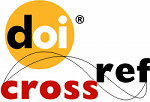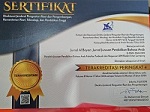The Use of Dictionary for Arabic Language Textbook to Improve The Students' Reading Skill l Istikhdam al-Mu’jam li Kitab Ta’lim al-Lugah al-‘Arabiyyah li Tanmiyyah Maharah al-Qira’ah lada al-Talabah
Abstract
Keywords
Full Text:
PDFReferences
A., B. Al-Said. “Computerizing Historical Arabic Dictionary.” Journal of Lissan Alarab, Maktab Tansiq Al-Tarib 74 (2014).
Adib, Helen Sabera. “Teknik Pengembangan Instrumen Penelitian Ilmiah Di Perguruan Tinggi Keagamaan Islam.” In Teknik Pengembangan Instrumen Penelitian Ilmiah Di Perguruan Tinggi Keagamaan Islam”, Seminar Nasional Pendidikan, Sains Dan Teknologi, 2017.
Ahmala, Majidatun. “Kamus Aplikasi Sebagai Media Pendamping Buku ‘Al-‘Arabiyah Al-Mu’Asiroh.” Alfazuna 3, no. 1 (2018): 32–50.
Akyol, Hayati, and Yasemin Boyaci-Altinay. “Reading Difficulty and Its Remediation: A Case Study.” European Journal of Educational Research 8, no. 4 (2019): 1269–86. https://doi.org/. https://doi.org/10.12973/eu-jer.8.4.1269.
Aliwy, A H, and Ahmed A. Alethary. “Development of Arabic Sign Language Dictionary Using 3D Avatar Technologies.” Indonesian Journal of Electrical Engineering and Computer Science 21, no. 1 (2021): 609–16. https://doi.org/DOI: 10.11591/ijeecs.v21.i1. pp609-616.
Alruzzi, Kamal Ahmad, and Kamariah Binti Yunus. “Arabic Synonims in Bilingual Arabic-English Dictionaries.” International Journal of Innovation, Creativity and Change 8, no. 9 (2019): 254–61.
Ariawan, Soni. “Investigating Cultural Dimensions in EFL Textbook by Using Byram Checklist.” Register Journal 13, no. 1 (2020): 123–52. https://doi.org/https://doi.org/10.18326/rgt.v13i1.123-152.
Astuti, Widi. “Berbagai Strategi Pembelajaran Kosa Kata Bahasa Arab.” Jurnal Komunikasi Dan Pendidikan Islam 5, no. 2 (2016): 177–91.
Aziza, Lady Farah, and Ariadi Muliansyah. “Keterampilan Berbahasa Arab Dengan Pendekatan Komprehensif.” El-Tsaqafah 19, no. 1 (2020): 56–71.
Azzikri, Muhammad Hakim, and Zukhaira. “Pengembangan M-Kamus Istilah Penelitian Dalam Bahasa Arab Bagi Mahasiswa Pendidikan Bahasa Arab Universitas Negeri Semarang.” Lisania 3, no. 2 (2019): 128–42.
Bilmas, S. N. “Development of An Electronic Arabic Dictionary.” Universiti Teknologi Malaysia, 2009.
Daniel, O. C., S. R. Esoname, Oriogu-Ogbuiyi Darlina Chima, and O. S. Udoaku. “Effect of Reading Habit on The Academic Performance of Student: A Case Study of Afe Bablola University, Ado-Ekiti, Ekiti State.” Teacher Education and Curriculum Studies 2, no. 5 (2017): 74–80.
Efendi, Anwar. “Beberapa Catatan Tentang Buku Teks Pelajaran Di Sekolah.” Insania 14, no. 2 (2009): 320–33.
Fransiska, Fredina, and Zaim Elmubarok. “Efektivitas Metode Reading Guide Terhadap Keterampilan Membaca Bahasa Arab Siswa Kelas Xi Ips Man Demak.” Lisanul’ Arab: Journal of Arabic Learning and Teaching 4, no. 1 (2015). https://doi.org/10.15294/la.v4i1.7634.
Garbul, L. “On the Role of Historical Dictionaries in the Study of Inter-Slavic Language Contacts.” Voprosy Leksikografii 2019, no. 15 (2019): 141–53. https://doi.org/10.17223/22274200/15/9.
Halimah, Siti, Mahmu’ddin, and Desi Wahyuni. “Differences of Student Learning Results before and after Using the Picture and Picture Learning Model through Audio-Visual Media.” In Journal of Physics: Conference Series 1477 042025, 2020.
Hanafi. “Konsep Penelitian R&D Dalam Bidang Pendidikan.” Saintifika Islamica 4, no. 2 (2017): 129–50.
Hidayah, Nurul, and Umi Kulsum Nur Qomariyah. “Kamus Tematik Sains Sebagai Upaya Meningkatkan Penguasaan Kosa Kata Bahasa Arab Mahasiswa Biologi.” Allahjah 5, no. 2 (2020): 20–28.
Holidazia, Rupina, and Rojab Siti Rodliyah. “Strategi Siswa Dalam Pembelajaran Kosa Kata Bahasa Inggris.” Jurnal Penelitian Pendidikan 20, no. 1 (2020): 111–20.
Huda, Nurul, and Nabilah Ulfa. “Pengembangan Kamus Arab-Indonesia Sebagai Penunjang Buku Ajar Madrasah Tsanawiyyah Di Kelas VIII.” Alfazuna 3, no. 2 (2019): 211–30.
Ibrahim, M. N., S. N. Bilmas, A. Babiker, and M. Idroas. “Electronic Multilingual Arabic Dictionary Based on Root -Word with Self-Assessment.” In UKSim-AMSS 16th International Conference on Computer Modelling and Simulation, Cambridge, UK, 311–17, 2014. https://doi.org/doi: 10.1109/UKSim.2014.112.
Jinxiu, J., and Z. Zhengpung. “Principles and Implementation of Reading Activities in Primary School English Class.” English Language Teaching 9, no. 12 (2016): 74–78. https://doi.org/doi:10.5539/elt.v9n12p74.
Khan, Raja Muhammad Ishtiaq, Muhammad Shahbaz, Tribhuwan Kumar, and Imran Khan. “Investigating Reading Challenges Faced by EFL Learners at Elementary Level.” Register Journal 13, no. 2 (2020): 277–92. https://doi.org/https://doi.org/10.18326/rgt.v13i2.277-292.
Khezrlou, Sima, Rod Ellis, and Karim Sadeghi. “Effects of Computer-Assisted Glosses on EFL Learners’ Vocabulary Acquisition and Reading Comprehension in Three Learning Conditions.” System 65 (2017): 104–16. https://doi.org/https://doi.org/10.1016/j.system.2017.01.009.
Listiawan, Tomi. “Pengembangan Learning Management System (LMS) Di Program Studi Pendidikan Matematika STKIP PGRI Tulungagung.” JIPI (Jurnal Ilmiah Pendidikan Informatika) 1, no. 1 (2016): 14–22.
Madkur, Ali Ahmad. Tadris Funun Al-‘Arabiyyah. Cairo: Dar al-Fikr al-’Arabiy, 2002.
Mahmudin, Wildan. “Problematika Pembelajaran Al-Qira’ah Da Solusi Pemecahannya (Studi Deskriptif Kualitatif Di MA Miftahurrahman Tasikmalaya).” Thoriqotuna 1, no. 1 (2018): 135–62.
Mukholifah, Madinatul, Urip Trisngati, and Vit Ardhyantama. “Mengembangkan Media Pembelajaran Wayang Karakter Pada Pembelajaran Tematik.” Jurnal Inovasi Penelitian 1, no. 4 (2020): 673–82.
Mutholib, Abdul. “Lu’batul Qamus: Cara Unik Memperkaya Mufradat.” Arabia 7, no. 1 (2015): 65–87.
Nurcholis, Ahmad, Syaikhu Ihsan Hidayatullah, and Muhamad Asngad Rudisunhaji. “Karakteristik Dan Fungsi Qira’ah Dalam Era Literasi Digital.” El-Tsaqafah 18, no. 2 (2019): 131–46.
Osei, Aboagye Michael, Qing Jing Liang, Ihnatushschenko Natalia, and Mensah Abrampah Stephen. “The Use of Pre-Reading Activities in Reading Skills Achivement in Preschool Education.” European Journal of Educational Reasearch 5, no. 1 (2016): 35–42. https://doi.org/doi:10.12973/eu-jer.5.1.35.
Purnama, Sigit. “Metode Penelitian Dan Pengembangan (Pengenalan Untuk Mengembangkan Produk Pembelajaran Bahasa Arab).” Literasi 4, no. 1 (2013): 19–32.
Purwanti, Christina. “Eksistensi Bahasa Dalam Komunikasi Interpersonal: Sebuah Pendekatan Interdisipliner (Language Existence in Interpersonal Communication: An Interdiciplinary Approach).” Polyglot 16, no. 2 (2020): 266–81.
Putri, Nike Aditya, and Tommi Yuniawan. “Pengembangan Kamus Bergambar Berwawasan Cinta Indonesia Berbasis Aplikasi Android Sebagai Media Pembelajaran Bagi Mahasiswa Penutur Asing.” Lingua 13, no. 1 (2017): 60–67.
R., Laatar, Aloulou C., and Hadrich Belguith L. “Towards a Historical Dictionary for Arabic Language.” Int J Speech Technol, 2020. https://doi.org/https://doi.org/10.1007/s10772-020-09704-z.
Rahmawati, Gustini. “Buku Teks Pelajaran Sebagai Sumber Belajar Siswa Di Perpustakaan Sekolah Di SMAN 3 Bandung.” Edulib 5, no. 1 (2015): 102–13.
Ritonga, Mahyudin, Asrina, Rizka Widayanti, Fitri Alrasi, Julhadi, and Syaflin Halim. “Analysis of Arabic Language Learning at Higher Education Institutions with Multi-Religion Students.” Universal Journal of Educational Research 8, no. 9 (2020): 4333–39. https://doi.org/DOI: 10.13189/ujer.2020.080960.
Robbani, A. Syahid, and Ahmad Muzayyan Haqqy. “Alternatif Pembelajaran Maharah Qira’ah Dengan Kisah-Kisah Dalam Al-Qur’an.” EL-Tsaqafah 19, no. 2 (2020): 186–98.
Rosiyana, Shilvia, Retno Purnama Irawati, and Hasan Busri. “Efektivitas Model Reflective Teaching Bagi Peningkatan Keterampilan Berbicara Dan Membaca Bahasa Arab Siswa Kelas VIII MTs Al Irsyad Gajah Demak.” Lisanul’ Arab: Journal of Arabic Learning and Teaching 6, no. 1 (2017): 29–37.
Saptiani. “Pengembangan Media Pembelajaran Kamus Tematik Tiga Bahasa (Indonesia, Arab, Inggris) Untuk Menstimulasi Kognitif Anak Usia Dini.” Bunayya 1, no. 2 (2016): 100–118.
Siyabi, M. S. “Integrating True Short Stories into English Classes: The Case of Foundation Students in Oman.” English Language Teaching 10, no. 3 (2017): 164–70. https://doi.org/doi:10.5539/elt.v10n3p164.
Sugiyono. Metode Penelitian Pendidikan (Pendekatan Kuantitatif, Kualitatif, Dan R&D). 21st ed. Bandung: Alfabeta, 2015.
Sulastri. “Pengembangan Media Pembelajaran Arabic Tematic Video Pada Keterampilan Berbicara Bagi Siswa Kelas VIII MTs.” Lisanul’ Arab: Journal of Arabic Learning and Teaching 5, no. 1 (2016): 21–27.
Toha, Mohammad. “Pembelajaran Bahasa Arab Dengan Pendekatan Manajemen Berbasis Sekolah.” Okara 1, no. 7 (2012): 79–90.
Unsi, Baiq Tuhfatul. “Media Gambar Dalam Pembelajaran Kosakata Bahasa Arab.” Tafaqquh 2, no. 1 (2014): 26–44.
Wahidah, Zulfa Amalia, Umi Baroroh, and Rasheed Mahmoud-Mukadam. “The Implementation of Eclectic Methods in Arabic Learning Based on All in One System Approach.” Jurnal Al Bayan: Jurnal Jurusan Pendidikan Bahasa Arab 13, no. 1 (2021): 90–107. https://doi.org/https://doi.org/10.24042/albayan.v13i1.6379.
Widamelia, Putri Buchika, and M. Shodiq AM. “Media Kamus Bahasa Indonesia Bergambar Untuk Meningkatkan Pemahaman Kosakata Siswa Tunarungu.” Jurnal Ortopedagogia 4, no. 2 (2018): 109–14.
Zuo, W. “The Effects of Cooperative Learning on Improving College Students’ Reading Comprehension.” Theory and Practice in Language Studies 1, no. 8 (2011): 986–89. https://doi.org/doi:10.4304/tpls.1.8.986-989.
DOI: http://dx.doi.org/10.24042/albayan.v13i2.8620
Refbacks
- There are currently no refbacks.
Copyright (c) 2021 Jurnal Al Bayan: Jurnal Jurusan Pendidikan Bahasa Arab
License URL: https://creativecommons.org/licenses/by-sa/4.0
Editorial Office:
Jurnal Al Bayan: Jurnal Jurusan Pendidikan Bahasa Arab, Arabic Education Study Program, Faculty of Education and Teachers Training, Unversitas Islam Negeri Raden Intan Lampung
Jl. Endro Suratmin 1 Sukarame, Bandar Lampung 35131-Indonesia
e-mail: jurnalalbayan@radenintan.ac.id
http://ejournal.radenintan.ac.id/index.php/albayan/index
Jurnal Al Bayan: Jurnal Jurusan Pendidikan Bahasa Arab is licensed under a Creative Commons Attribution-ShareAlike 4.0 International License. p-ISSN 2086-9282 | e-ISSN 2549-1229









